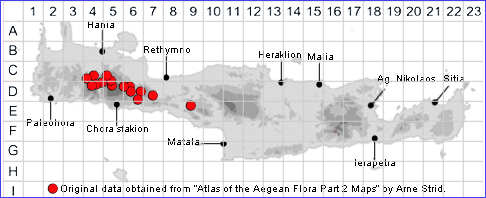HYPERICUM KELLERI
Family and Genus:- See- GUTTIFERAE/Sect. DROSOCARPIUM
Common Names:- None
Homotypic Synonyms:- Hypericum baldaccii.
Meaning:- Hypericum (Gr) Above-pictures. A name used by the Greek physician
and botanist Dioscorides for its use over shrines to repel evil spirits.
Kelleri (L) For Engelhardt Keller, nineteenth-century German writer.
General description:- Small, mat-forming perennial herb with a somewhat
woody taproot.
Stems:-
1) 1-5(-10) cm, procumbent, branching and rooting.
Leaves:-
1) Opposite, subsessile, 2-6 mm, oblong-elliptical, without or with few black
glandular dots, glabrous.
Flowers:-
1) Usually solitary, short-pedicellate, 4- or 5-merous.
2) Sepals, oblong-lanceolate, acute, with superficial black dots and streaks, and
with some minutely gland-tipped fimbriae towards apex.
3) Buds, red, expanded petals golden yellow, 5-7 mm, with marginal black glands.
Fruit:-
1) Capsule, ovoid, with longitudinal vittae. and round or elongated, orange vesicles.
2) Seeds, reticulate-pitted.
Key features:-
1) Sepals, with marginal or intramarginal black glands.
2) Leaves, 2-6 mm, hairy or papillose on both sides. or undulate.
3) Capsule, with vesicles as well as vittae.
4) Seeds, reticulate-pitted
5) Stems 1-5(-10) cm, procumbent, glabrous or finely papillose
Habitat:- Seasonally flooded clay-flats in dolines, occasionally in fallow fields. (500-
)900-1800 m.
Distribution:- Endemic to the mountains of western Crete and probably confined to
the Lefka Ori with one location on Psiloritis.
Flowering time:- May-July.
Photos by:- Fotis Samaritakis
Status:-
Conservation status (for threatened species): Vulnerable (V) according to the Red
Data Book of Rare and Threatened Plants of Greece (1995).
Vulnerable (V) according to IUCN 1997.
Protection status (for threatened species): Greek Presidential Decree 67/1981
SPECIES DESCRIPTION

